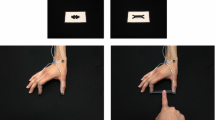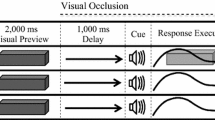Abstract
Grasping a three-dimensional (3D) object results in the specification of motor output via absolute size information. In contrast, the impoverished visual cues (e.g., binocular and vergence) associated with grasping a two-dimensional (2D) object are reported to render aperture formation via an object’s perceptual and relative visual features. It is, however, important to recognize that 3D and 2D grasping differ not only in terms of their visual properties, but also because the latter does not entail the provision of haptic feedback. As such, the present work examined whether haptic feedback influences the nature of the information supporting 2D grasping. Participants grasped differently sized 3D objects (i.e., 3D task) and completed a ‘traditional’ 2D grasping task to line drawings without receiving haptic feedback (i.e., 2DH− task). As well, we included a separate condition using the same objects as the 2DH− task; however, the experimenter placed a 3D object (i.e., one corresponding to the size of the 2D object) between the thumb and forefinger of participants’ grasping limb once they completed their response (i.e., 2DH+ task). Thus, the 2DH+ task provided haptic feedback related to absolute object size. Notably, we computed just-noticeable-difference (JND) scores to determine whether the different tasks adhered to, or violated, the relative psychophysical principles of Weber’s law. JNDs for the 2DH− task adhered to Weber’s law, whereas 3D and 2DH+ tasks violated the law. Thus, results evince that 2DH− and 2DH+ tasks are specified via relative and absolute object size information, respectively. Accordingly, we propose that haptic feedback supports an absolute visuo-haptic calibration and contend that our results highlight the importance of multi-sensory cue integration in goal-directed grasping.




Similar content being viewed by others
Notes
We report %tPGA so that our findings can be conceptualized within the well-known normalized time frame for PGA (i.e., 76 % of MT) (see Jeannerod 1984). That said, the results and interpretation for absolute time to PGA mirrored those of %tPGA. In particular, results yielded main effects for task, F(2,34) = 15.94, p < 0.001, η 2p = 0.48, and object size, F(3,51) = 8.18, p < 0.001, η 2p = 0.32: time to PGA occurred earlier for the 3D (515 ms, SD = 45) compared to the 2DH− (585 ms, SD = 69) and 2DH+ (577 ms, SD = 87) tasks [ts(17) = 5.69 and 3.69, ps < 0.001] which did not differ (t(17) < 1), and values increased linearly with increasing object size [only linear effect significant: F(1,17) = 11.08, p < 0.01].
Although post hoc analyses showed that PGAs for the 20-mm object did not reliably differ between the 2DH− and 2DH+ tasks, Fig. 3 shows that the mean value for the latter task was larger. Thus, the direction of the difference between the 2DH− and 2DH+ tasks for the 20-mm object is consistent with the statistically reliable between-tasks differences reported for the larger object sizes used here (i.e., 30, 40, and 50 mm).
References
Bingham G, Coats R, Mon-Williams M (2007) Natural prehension in trials without haptic feedback but only when calibration is allowed. Neuropsychologia 45:288–294
Brainard DH (1997) The psychophysics toolbox. Spat Vis 10:433–436
Cavina-Pratesi C, Kuhn G, Ietswaart M, Milner AD (2011) The magic grasp: motor expertise in deception. PLoS ONE 6:e16568
Christiansen JH, Christensen J, Grünbaum T, Kyllingsbæk S (2014) A common representation of spatial features drives action and perception: grasping and judging object features within trials. PLoS ONE 9:e94744
Cumming G (2013) Understanding the new statistics: effect sizes, confidence intervals, and meta-analysis. Routledge, New York
Davarpanah Jazi S, Heath M (2014) Weber’s law in tactile grasping and manual estimation: feedback-dependent evidence for functionally distinct processing streams. Brain Cogn 86C:32–41
Davarpanah Jazi S, Hosang S, Heath M (2015a) Memory delay and haptic feedback influence the dissociation of tactile cues for perception and action. Neuropsychologia 71:91–100
Davarpanah Jazi S, Yau M, Westwood DA, Heath M (2015b) Pantomime-grasping: the ‘return’ of haptic feedback supports the absolute specification of object size. Exp Brain Res 233:2029–2040
Ernst MO, Banks MS (2002) Humans integrate visual and haptic information in a statistically optimal fashion. Nature 415:429–433
Fitts PM (1954) The information capacity of the human motor system in controlling the amplitude of movement. J Exp Psychol Gen 47:381–391
Freud E, Ganel T (2015) Visual control of action directed toward two-dimensional objects relies on holistic processing of object shape. Psychon Bull Rev 22:1377–1382
Fukui T, Inui T (2013) How vision affects kinematic properties of pantomimed prehension movements. Front Psychol 4:44
Ganel T, Chajut E, Algom D (2008) Visual coding for action violates fundamental psychophysical principles. Curr Biol 18:R599–R601
Ganel T, Freud E, Chajut E, Algom D (2012) Accurate visuomotor control below the perceptual threshold of size discrimination. PLoS ONE 7:e36253
Gibson JJ (1986) The ecological approach to visual perception. Routledge, Boston
Goodale MA (2011) Transforming vision into action. Vision Res 51:1567–1587
Goodale M, Milner D (2013) Sight unseen: an exploration of conscious and unconscious vision. Oxford University Press, Oxford
Goodale MA, Jakobson LS, Keillor JM (1994) Differences in the visual control of pantomimed and natural grasping movements. Neuropsychologia 32:1159–1178
Heath M, Mulla A, Holmes SA, Smuskowitz LR (2011) The visual coding of grip aperture shows an early but not late adherence to Weber’s law. Neurosci Lett 490:200–204
Heath M, Holmes SA, Mulla A, Binsted G (2012) Grasping time does not influence the early adherence of aperture shaping to Weber’s law. Front Hum Neurosci 6:332
Holmes SA, Heath M (2013) Goal-directed grasping: the dimensional properties of an object influence the nature of the visual information mediating aperture shaping. Brain Cogn 82:18–24
Holmes SA, Mulla A, Binsted G, Heath M (2011) Visually and memory-guided grasping: aperture shaping exhibits a time-dependent scaling to Weber’s law. Vision Res 51:1941–1948
Holmes SA, Lohmus J, McKinnon S, Mulla A, Heath M (2013) Distinct visual cues mediate aperture shaping for grasping and pantomime-grasping tasks. J Mot Behav 45:431–439
James TW, Culham J, Humphrey GK, Milner AD, Goodale MA (2003) Ventral occipital lesions impair object recognition but not object-directed grasping: an fMRI study. Brain 126:2463–2475
Janssen P, Vogels R, Orban GA (2000) Selectivity for 3D shape that reveals distinct areas within macaque inferior temporal cortex. Science 288:2054–2056
Jeannerod M (1984) The timing of natural prehension movements. J Mot Behav 16:235–254
Kanwisher N, Chun MM, McDermott J, Ledden PJ (1996) Functional imaging of human visual recognition. Brain Res Cogn Brain Res 5:55–67
Kwok RM, Braddick OJ (2003) When does the Titchener Circles illusion exert an effect on grasping? Two- and three-dimensional targets. Neuropsychologia 41:932–940
Lederman SJ, Klatzky RL (2009) Haptic perception: a tutorial. Atten Percept Psychophys 71:1439–1459
Lemay M, Proteau L (2001) A distance effect in a manual aiming task to remembered targets: a test of three hypotheses. Exp Brain Res 140:357–368
Loftus GR, Masson ME (1994) Using confidence intervals in within-subject designs. Psychon Bull Rev 1:476–490
Maunsell JH, Van Essen DC (1983) Functional properties of neurons in middle temporal visual area of the macaque monkey. II. Binocular interactions and sensitivity to binocular disparity. J Neurophysiol 49:1148–1167
Milner AD, Ganel T, Goodale MA (2012) Does grasping in patient D.F. depend on vision? Trends Cogn Sci 16:256–257 (discussion 258–259)
Pedhazur EJ (1997) Multiple regression in behavioral research: explanation and prediction. Harcourt Brace College Publishers, Orlando
Pettypiece CE, Goodale MA, Culham JC (2010) Integration of haptic and visual size cues in perception and action revealed through cross-modal conflict. Exp Brain Res 201:863–873
Schenk T (2012) No dissociation between perception and action in patient DF when haptic feedback is withdrawn. J Neurosci 32:2013–2017
Smeets JB, Brenner E (1999) A new view on grasping. Mot Control 3:237–271
Snow JC, Pettypiece CE, McAdam TD, McLean AD, Stroman PW, Goodale MA, Culham JC (2011) Bringing the real world into the fMRI scanner: repetition effects for pictures versus real objects. Sci Rep 1:130
Turnbull OH, Driver J, McCarthy RA (2004) 2D but not 3D: pictorial-depth deficits in a case of visual agnosia. Cortex 40:723–738
Viau A, Feldman AG, McFadyen BJ, Levin MF (2004) Reaching in reality and virtual reality: a comparison of movement kinematics in healthy subjects and in adults with hemiparesis. J Neuroeng Rehabil 1:11
Vishton PM, Rea JG, Cutting JE, Nuñez LN (1999) Comparing effects of the horizontal-vertical illusion on grip scaling and judgment: relative versus absolute, not perception versus action. J Exp Psychol Hum Percept Perform 25:1659–1672
Westwood DA, Chapman CD, Roy EA (2000) Pantomimed actions may be controlled by the ventral visual stream. Exp Brain Res 130:545–548
Westwood DA, Danckert J, Servos P, Goodale MA (2002) Grasping two-dimensional images and three-dimensional objects in visual-form agnosia. Exp Brain Res 144:262–267
Whitwell RL, Buckingham G (2013) Reframing the action and perception dissociation in DF: haptics matters, but how? J Neurophysiol 109:621–624
Whitwell RL, Milner AD, Cavina-Pratesi C, Byrne CM, Goodale MA (2014) DF’s visual brain in action: the role of tactile cues. Neuropsychologia 55:41–50
Acknowledgments
This work was supported by a Discovery Grant from the Natural Sciences and Engineering Research Council of Canada and Faculty Scholar and Major Academic Development Fund Awards from the University of Western Ontario. SH was supported by an Undergraduate Student Research Award from the Natural Sciences and Engineering Research Council of Canada.
Author information
Authors and Affiliations
Corresponding author
Rights and permissions
About this article
Cite this article
Hosang, S., Chan, J., Davarpanah Jazi, S. et al. Grasping a 2D object: terminal haptic feedback supports an absolute visuo-haptic calibration. Exp Brain Res 234, 945–954 (2016). https://doi.org/10.1007/s00221-015-4521-4
Received:
Accepted:
Published:
Issue Date:
DOI: https://doi.org/10.1007/s00221-015-4521-4




